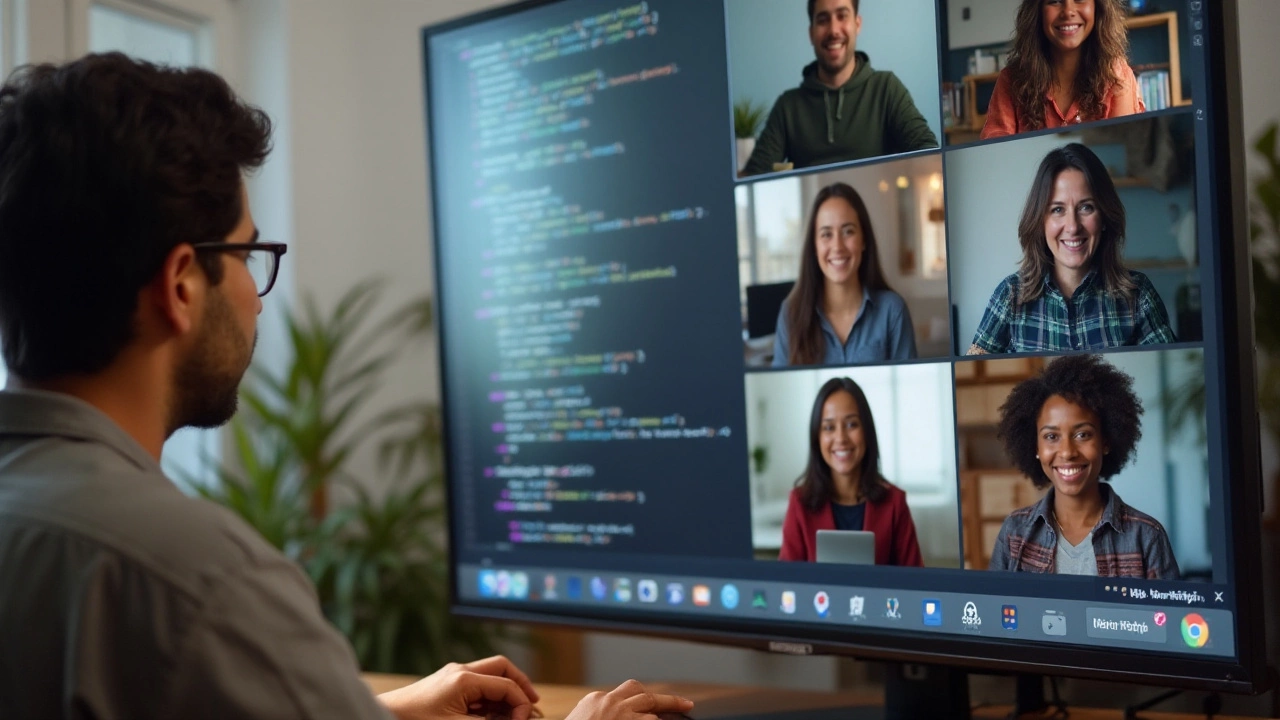The question of how long it takes to learn coding doesn't have a straightforward answer. It's akin to asking how long it takes to learn a new instrument or a foreign language. The journey is different for everyone, shaped by personal goals, dedication, and the learning methods chosen.
Some might find themselves writing basic programs within a few weeks, especially if they immerse themselves in intensive courses or bootcamp programs. For others, it might be a longer road, filled with experimentation, trial and error, and lots of practice.
This article delves into the nuances of learning to code, offering guidance on choosing the right programming language, setting achievable goals, and overcoming common stumbling blocks. Here, you will find practical tips to make your coding journey as smooth as possible and insights into the various factors that can influence the time it takes to reach your programming aspirations.
- Understanding the Basics
- Choosing the Right Language
- Timeframes: Short-term vs Long-term Learning
- Effective Learning Methods
- Common Challenges and Solutions
- Measuring Progress and Setting Goals
Understanding the Basics
When embarking on the journey to learn coding, one begins with the basics. Grasping foundational concepts is essential and involves understanding what coding truly entails. Coding, at its core, is about solving problems using logical sequences of instructions. As you start, it’s crucial to familiarize yourself with terms like syntax, variables, control structures, and algorithms. These are building blocks for any programming language you choose. Having a solid grasp on these concepts allows you to approach coding tasks with confidence and lays a foundation for more complex skills.
Choosing the right approach to start understanding these basics is important. Many successful coders recommend beginning with a high-level language like Python due to its ease of understanding and simplicity in syntax. It serves as an excellent introduction to programming because it allows users to see results efficiently without getting lost in complex syntax. What you are essentially doing is communicating with the computer in a language it understands: the more familiar you are with this language, the better you can express your ideas and solutions in a programmatic form. Diving into resources like online tutorials, coding books specifically aimed at beginners, or enrolling in beginner-friendly coding classes can significantly help.
Developing problem-solving skills is another key aspect of learning to code. According to Steve Jobs, "Everybody in this country should learn to program a computer because it teaches you how to think."
It’s not just about writing lines of code but understanding how to break down a problem into manageable parts, and devising a step-by-step solution. This analytical mindset is what coding instills, and it can be invaluable in both professional and personal contexts.To foster this mindset, start with simple coding problems. As you become more comfortable, gradually move to more complex challenges. Websites like LeetCode and CodeSignal offer a variety of problems that can help you practice and refine your skills.
Engagement is also essential when starting to code. Joining online communities such as Stack Overflow or GitHub can provide support and foster learning. Engaging with like-minded learners and experienced coders opens up opportunities for knowledge exchange, allowing you to view problems from different perspectives. You will also find that many coding communities are welcoming to newcomers, offering help through forums and collaborative projects. This network not only motivates but provides diverse viewpoints on solving coding challenges. Remember, coding is not meant to be a solitary path; collaboration and sharing ideas are integral to the process. As you share and build on others’ code, you enhance your abilities while contributing to the wider community.
Building small projects utilizing the basics is a great method to solidify understanding. Start simple: maybe a calculator app or a basic to-do list application. These projects may seem trivial, but they're excellent exercises in applying fundamental coding skills in practical ways. Once you've built something on your own, the confidence and understanding of your abilities will grow rapidly. This also gives you a tangible sense of progress as you transition from learning theory to applying knowledge practically. Make use of iteration: reflect on what you've built, ask for peers' feedback, and improve on it. This process mirrors the real-world software development cycle and will greatly benefit your learning journey.
Ultimately, learning coding basics is about mindset as much as skill set. Stay curious, be patient with yourself, and do not shy away from challenges. Coding teaches persistence—it might not come instantly, but with consistent effort and the right resources, you'll find yourself understanding the language of computers sooner than you'd expect. The path to mastering coding starts with these small, steady steps.
Choosing the Right Language
Embarking on your coding journey often begins with a crucial decision: selecting the right programming language. It's a bit like standing at a crossroads with multiple paths stretching out before you. Each language offers unique strengths and is suited for different types of projects, making the choice sometimes overwhelming. However, setting the stage with the right language can significantly influence your learning curve and confidence as you begin. Instead of getting lost in the myriad options, focus on your personal goals and the type of projects you wish to create. Are you drawn to web development, game design, or data analysis? Understanding your interests and objectives can help narrow down your options effectively.
For those stepping into the world of coding with a focus on web development, HTML and CSS are fundamental building blocks. They're straightforward, enabling beginners to craft static web pages quickly. Once comfortable with these, JavaScript becomes your next ally, allowing the addition of interactivity and enhancing user experience on websites. JavaScript has a vibrant ecosystem, with libraries and frameworks like React and Angular that make it a staple in modern web development. If app development is your ambition, Swift is an excellent language for iOS, while Kotlin is preferred for Android. Both languages offer a clean syntax, making them accessible for newcomers while providing the power needed for professional-grade applications.
Backend development often demands understanding of server-side languages, and here Python shines. Known for its clarity and versatility, Python is used across a broad spectrum of applications, from web development and data science to artificial intelligence. Python's syntax is readable and intuitive, which eases the learning process, making it a favorite among beginners and educators alike. For a more traditional route, Java remains a powerhouse in the tech world, used extensively in enterprise environments and large-scale applications. With Java’s write-once, run-anywhere philosophy, it ensures code portability across platforms.
"Pick a language that matches your ambitions and curiosity. The perfect language for learning coding is the one that aligns with both your current and future aspirations." - Paul Irish, Developer Advocate
It's important to realize that there's no one-size-fits-all solution when choosing a language to learn coding. Instead, focus on the journey. Experiment with different languages and projects to find your passion. Embracing this explorative approach not only develops a solid programming foundation but also instills the adaptability to learn additional languages down the road with ease. In the tech world, new technologies emerge rapidly and having a versatile learning strategy is crucial. Remember, it's not just the language you choose, but the problem-solving mindset you cultivate that truly matters.
Consider also the available learning resources, community support, and career opportunities associated with each language. JavaScript, for instance, boasts a vast community and abundant tutorials, making problem-solving and learning new techniques incredibly accessible. Conversely, languages like Rust or Go are emerging with a distinct focus on performance and efficiency, and their communities, although smaller, are passionate and welcoming. Aligning your language choice with industry demands can also provide a tactical advantage in the job market. A simple table like the one below illustrates the occupational preference for certain languages:
| Language | Common Uses |
|---|---|
| Python | Data Science, Web Development |
| JavaScript | Front-end Development, Web Applications |
| Java | Enterprise-Level Applications |
| Swift | iOS Application Development |
| Kotlin | Android Development |
Delve into building projects, joining online forums, and collaborating with fellow learners to reinforce your understanding. These practices not only help solidify your knowledge but also build a portfolio that showcases your skills to future employers. Transitioning from theory to practical application is crucial, and each milestone will build your confidence and capabilities, guiding your coding journey in the right direction.

Timeframes: Short-term vs Long-term Learning
When embarking on the journey to learn coding, one of the most significant considerations is the time you can dedicate. For some, the prospect of learning in a short time is motivating, while others may find long-term learning more impactful. The distinction between short-term and long-term learning can profoundly influence your speed and depth of knowledge. Short-term learning, such as bootcamps or intensive courses, typically spans anywhere from a few weeks to a few months. These programs are designed to quickly immerse students into the world of coding, often requiring up to 60 hours a week of study and practice. This intense focus can lead to rapid acquisition of programming skills and a superficial understanding of multiple concepts. However, there is a danger of speed overshadowing comprehension, as the breadth of topics covered in such a short time might not allow for deeper exploration.
On the other hand, long-term learning takes a more traditional approach, often through part-time courses, self-study, or even formal education at a university level, which can spread across several years. This extended time frame allows learners to delve into complex topics at a comfortable pace, solidifying their understanding and retaining information longer. With more time available, one can experiment, make mistakes, and truly grasp the underlying principles of coding. According to a study by Stack Overflow, developers who engage in continuous learning tend to have a broader skill set and adapt more readily to evolving technologies.
Each approach has its place, and choosing between them depends on your personal circumstances and career goals. If you need to quickly shift to a career in tech or bolster your current role with coding skills, the short-term path may be ideal. However, if you're able to invest more time and wish to integrate coding into a more comprehensive skill set, long-term learning might suit you best. Legendary coder and author, Robert C. Martin, often expressed in workshops that "coding is a craft, and like any craft, it takes time to master."
Regardless of the path chosen, it's crucial to remember the vital role of continuous practice and real-world application. Balancing theory with hands-on projects can help reinforce what you've learned, whether in a short span or over years. There aren't rigid rules dictating which path to choose. Instead, consider your available time, career objectives, and preferred learning style to find what works best for you. And remember, your coding journey doesn't end at mastering a language; it's about staying curious and constantly evolving with the tech landscape.
Effective Learning Methods
When embarking on the path to learn coding, it's crucial to adopt effective learning methods that can streamline the process and amplify your understanding. One of the key factors in successful learning is finding the right balance between theory and practice. Just diving deep into books or online tutorials isn't enough. Combining this theoretical knowledge with hands-on experience helps solidify concepts more robustly. Experimentation in coding is essential since it allows learners to see their newly acquired knowledge in action, and just as a musician practices scales, a coder must practice syntax and algorithms until they are second nature.
Another method is to join coding communities or forums where seasoned programmers and novice learners converge. Participating in groups such as Reddit's coding community or Stack Overflow can provide valuable insights and quick answers to pressing questions. It's fascinating how often a simple query can unravel layers of deeper understanding when discussed with a community of like-minded individuals. Mentorship, whether through formal arrangements or casual interactions, can also boost your learning curve, providing personalized guidance and feedback from those who have walked the road you're on.
"The only way to learn a new programming language is by writing programs in it," advised Dennis Ritchie, creator of the C programming language. His words emphasize the importance of consistent coding practice to internalize key concepts and techniques.
Embracing innovative learning platforms such as Codecademy, Coursera, or Udemy can also be beneficial. These platforms often offer interactive courses that provide immediate feedback on your code, assisting in a more dynamic learning process. They bridge the gap between bookish knowledge and real-world application by providing projects that mimic those professionals face on a daily basis. Many platforms offer certificates upon completion, adding value to your professional journey while thoroughly ingraining skills.
Some learners might find benefit in structured schedules where coding becomes habitual, much like daily exercise. Dedicating a specific timeframe every day to practice programming skills ensures consistent progress and helps form long-lasting habits. This structured approach can also involve setting small, achievable goals, and celebrating each milestone, which fuels motivation. On the other hand, some prefer a more flexible, curiosity-driven method, allowing their interests to guide what they explore next.
Lastly, incorporating peer reviews and collaborating on projects can result in exponential growth. Understanding how someone else approaches a problem can shed light on new strategies and techniques you hadn't considered. Collaborative platforms like GitHub provide fertile ground for shared projects and open-source contributions, which not only enhance coding skills but also help build a network of professional contacts, crucial for career advancement in the tech industry.

Common Challenges and Solutions
Embarking on the path to learn coding is often a thrilling venture, but it can also be lined with a variety of hurdles. A frequent obstacle that learners encounter is dealing with the complexity and vastness of programming concepts. It's easy to feel overwhelmed when faced with the intricate syntax of a new programming language or the intricate structure of coding logic. This challenge is part of what makes coding an art; it's like solving complex puzzles, requiring patience and persistence. Understanding that these hurdles are a natural part of the learning process helps build resilience. Take breaks when your brain feels overloaded, and try to approach the problem later with a fresh perspective. Remember, progress in coding, as with any skill, often comes in sudden leaps rather than linear steps.
Another common issue is debugging, which is something every programmer must master. Errors and bugs are inevitable in coding, but they provide a rich learning experience. Learning to read error messages effectively and using tools like debuggers can significantly ease this process. Compiling a list of common errors for your chosen programming language can help reduce the frustration often associated with debugging. Quoting Steve McConnell, renowned in software engineering, "The toughest task is not writing code, it's understanding problems and breaking them down into manageable parts." With this mindset, you will start viewing errors less as failures and more as opportunities to enhance your understanding.
Another significant hurdle is maintaining motivation, particularly for self-learners or those without a structured path. Coding can sometimes feel like a lonely journey, especially when learning independently. Finding a community, whether online or offline, can make a big difference. Engage with forums or join coding groups to share challenges, solutions, and successes. The camaraderie found in shared learning experiences can keep motivation levels high. Also, setting smaller, achievable milestones helps maintain a sense of progress and accomplishment. Embrace platforms that gamify learning, like coding challenges or competitions, as these can reignite enthusiasm and provide rewarding benchmarks.
When learning to code, time management becomes another pivotal factor to consider. Many beginners underestimate the time required to grasp fundamental concepts thoroughly. Balancing learning with other life commitments can be difficult, so it's crucial to create a realistic schedule. Break down your learning into bite-sized topics and allocate specific times for review and practice. Using a planner or a digital calendar aids in structuring this process. Don't forget to account for rest periods; mental fatigue can hinder creative problem-solving and slow down learning. A steady, paced approach is more sustainable than sporadic, intensive sessions.
Another challenge relates to the misconception of 'learning the wrong language.' There’s a tendency to switch languages frequently in search of the perfect one, which can slow down progress. Though some languages are preferred in certain industries, foundational programming concepts like loops, conditionals, and data structures are consistent across most languages. Choose a language that aligns with your goals, and commit to it initially to build a solid understanding. Over time, switching to another language becomes significantly easier once you're confident in your programming abilities. Focus on learning how to think as a programmer rather than mastering syntax alone.
Lastly, beginners often face difficulty when analyzing and applying algorithmic thinking. Many struggle to translate abstract problem statements into detailed program code. To alleviate this, practice solving real-world problems that pique your interest. Start with smaller, manageable problems and gradually increase their complexity. Working through well-documented problems from reputable coding platforms can provide clarity and improve confidence. Regularly challenging yourself with such problems helps improve logic development and analytical skills critical to programming.
Measuring Progress and Setting Goals
Embarking on a coding journey requires not only enthusiasm but also a well-thought-out plan to gauge advancement and set realistic targets. Understanding how to measure your progress can be the difference between feeling overwhelmed or inspired. Establishing effective ways to track your learning milestones provides a quantifiable approach to improving your programming skills. It's about setting clear goals that not only reflect your aspirations but also challenge you to push beyond your current limits.
Start by setting simple daily or weekly goals based on what you aim to achieve. Whether it's writing a certain number of lines of code, understanding a new concept, or completing a coding challenge, these small yet significant milestones build up over time. One effective method is to maintain a coding journal. Documenting what you learn each day provides a clear timeline of your progress and achievements. It's like creating a personalized guidebook that reflects your journey in nurturing your coding skills.
"Learning to write programs stretches your mind, and helps you think better, creates a way of thinking about things that I think is helpful in all domains," said Bill Gates, co-founder of Microsoft, emphasizing the universal benefits of learning coding.
Furthermore, many online platforms provide progress trackers. Websites like Codecademy and freeCodeCamp often have built-in systems that show how far along you are in a course or module. These visual indicators play a critical role in keeping you motivated and committed to improving your programming skills. By seeing the tangible results of your efforts, you stay engaged and keep pushing forward.
Alongside measuring progress, it's essential to set achievable yet challenging goals. The SMART criteria—Specific, Measurable, Achievable, Relevant, and Time-bound—is a useful framework in this aspect. By specifying precise goals, you create a roadmap that guides your daily learning activities. Measurable benchmarks allow you to track your advancement, ensuring you are always moving forward. Making goals achievable prevents discouragement, while relevance keeps your targets aligned with your broader learning objectives.
Finally, revisiting and adjusting your goals is a crucial habit. As you become more proficient, your initial objectives may become too easy or no longer applicable. Regularly re-evaluating your goals lets you adapt to new challenges and learning opportunities. This flexibility in goal-setting ensures continuous growth and development in your coding journey. So, remember to not only track your progress but consistently adjust your targets to keep your coding journey dynamic and rewarding.


